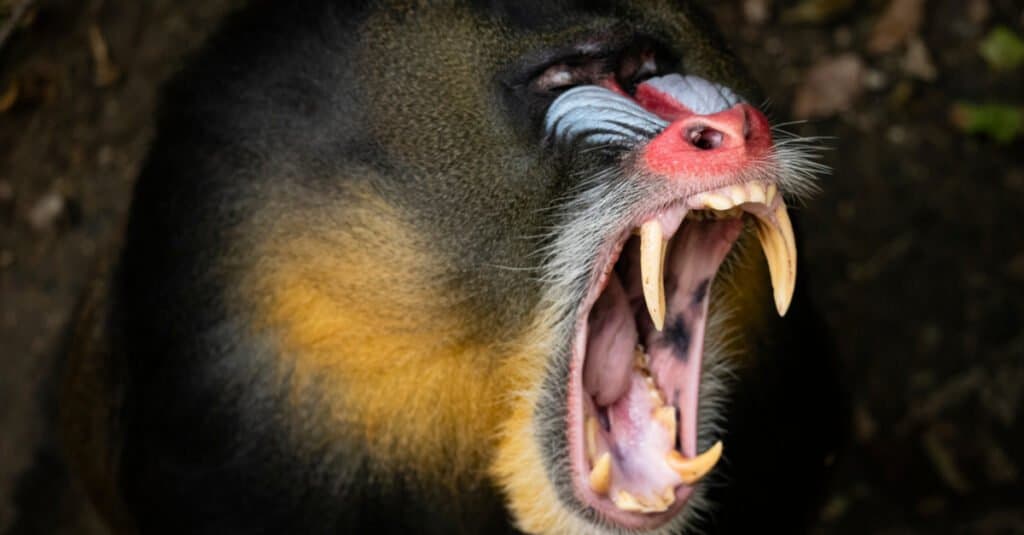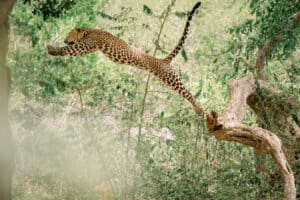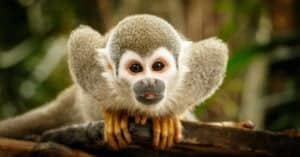Monkeys live throughout Asia, Africa, Central America, and South America. They’re distinct from other types of primate, like great apes (gorillas, chimpanzees, orangutans, bonobos, gibbons) and tarsiers. Scientists divide them into two primary groups; Old World monkeys, which live in Asia and Africa, and New World monkeys, which live in South and Central America. Monkeys run the gamut in size, behavior, habitat, lifespan, and diet. But, their teeth are strikingly similar to one another, and despite their differences in appearance–their teeth aren’t that different from ours.
Here, we’ll learn more about monkey teeth. Starting with New World monkeys, we’ll take a closer look at the teeth of pygmy marmosets, capuchins, and howler monkeys. Then, we’ll move on to Old World monkeys, and explore the teeth of Japanese macaques, mandrills, and proboscis monkeys. Along the way we’ll analyze the common characteristics of monkey teeth, and what makes these few species’ teeth unique.
New World Monkeys
New World monkeys (Platyrrhini) are those that live in Central and South America. They’re characterized by prehensile tails (in most species), forward facing eyes, an arboreal (tree-dwelling) lifestyle, and an omnivorous diet. New World monkey species include: marmosets, tamarins, capuchins, squirrel monkeys, night monkeys, titis, sakis, uakaris, howler monkeys, spider monkeys, and wooly monkeys.
Like most species of monkey, New World monkeys usually have 32 or 36 teeth; eight incisors, four canines, 8-12 premolars, and 8-12 molars. Let’s take a closer look at a few of the distinct mouths among these tropical monkeys.
Pygmy Marmoset Teeth
Pygmy marmosets are the smallest of all monkeys; you can hold an adult easily in the palm of your hand. They’re arboreal, and feed on insects, fruit, nectar, and tree sap. They have 32 teeth; eight incisors, four canines, 12 premolars, and eight molars. Their upper canines are large; they use them to latch onto trees. Then, with their bottom canines and incisors, they scrape at the tree until it produces sap, which they happily lap up.
Capuchin Teeth

Capuchin monkeys have either 32 or 36 teeth, depending on the specific species
©Ondrej Prosicky/Shutterstock.com
There are over 25 species of capuchin monkey in Central and South America. They’re historically famous accompaniments to organ masters, and can frequently be seen getting up to no good in films. They have 32 or 36 teeth, depending on the species; eight incisors, four canines, 12 premolars, and 8-12 molars. Capuchins are true omnivores; they’ll eat everything from seeds and fruits to small animals and insects. Their teeth are unique in that they have extraordinarily thick enamel designed to prevent fractures when they crack open tough nuts and seeds.
Howler Monkey Teeth
Howler monkeys are so named for their incredibly loud, raucous calls. They spend their lives in the trees, eating mostly leaves. They’ll also eat the occasional fruits, flowers, nuts, and seeds. All that leaf chewing means that they’ve got a pretty impressive set of chompers; 36 total teeth with eight incisors, four canines, 12 premolars, and 12 molars. They’ve got a massive mandible (lower jaw) to go along with all those teeth, and high crowns on their molars and premolars for chewing up leaves.
Old World Monkeys
Old World monkeys (Catarrhini) live in Africa and Asia. Some are arboreal, some are terrestrial, and some are a little of both. Unlike New World monkeys, they don’t usually have long tails. In general, they have 32 total teeth; eight incisors, four canines, eight premolars, and 12 molars.
Like New World monkeys, Old World monkeys are omnivorous, with each species having its own unique diet. Species of Old World monkeys include: baboons, colobus monkeys, geladas, mangabeys, mandrills, proboscis monkeys, and macaques. Let’s take a look at the specialized teeth of a few species of Old World monkey.
Japanese Macaque Teeth
Japanese macaques, otherwise known as the famous snow monkeys, spend a lot of their time hanging out in natural hot springs. When they’re not soaking, they eat a diet of fruit, seeds, flowers, leaves, and nectar–along with the occasional insect. They have 32 total teeth, with very large canines that can reach up to double the length of their incisors. And that’s saying something–Japanese macaques have truly massive incisors. They also have high, complex crowns on their molars and premolars designed for chewing up plant material.
Mandrill Teeth

Mandrill monkeys have 32 teeth, with incisors that can grow over two inches long
©Maciej Kopaniecki/Shutterstock.com
Mandrills are one of the showiest of all monkeys. Superficially, they resemble baboons. But, unlike baboons, mandrills have bright red and blue faces, with yellow fur on their necks. Coupled with their extraordinary coloring, males have truly massive canine teeth (over two inches long) that they use to demonstrate dominance in their social hierarchy. They have 32 teeth in total; eight incisors, four canines, eight premolars, and 12 molars. In addition to their canines, their lower first premolar is large and bladelike, with a sharp crown.
Proboscis Monkey Teeth
Proboscis monkeys are one of the most instantly recognizable of all Old World monkeys. They live arboreal lives in the mangrove swamps of Borneo, and males have one distinct feature; a large, pendulous nose. Behind that big nose is a mouth with 32 teeth; eight incisors, four canines, eight premolars, and 12 molars. They eat almost entirely leaves and fruit, with some seeds and insects thrown into the mix. They have large canines, and the first upper premolars are caniniform–meaning they look more like a canine than a premolar.
Can Monkeys Bite Humans?

©iStock.com/JicKaro
Monkeys can be anywhere from less to a pound in the case of the pygmy marmoset, to over seventy pounds for the male mandrill. They all have teeth; but does that mean they can all bite people?
Like all animals with mouths, monkeys can bite. However, they aren’t generally aggressive, and don’t seek out people to bite. Most species only bite when threatened and given no other option but to fight. They’re mostly herbivorous, and despite some species’ large canines–they’re not meant for tearing into flesh.
The photo featured at the top of this post is © iStock.com/Skouatroulio
Thank you for reading! Have some feedback for us? Contact the AZ Animals editorial team.







